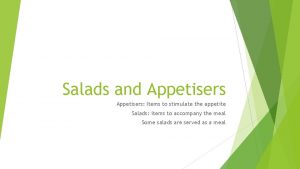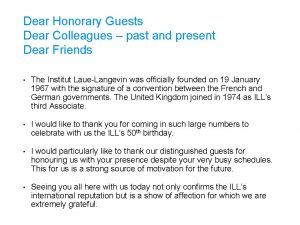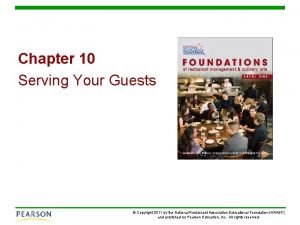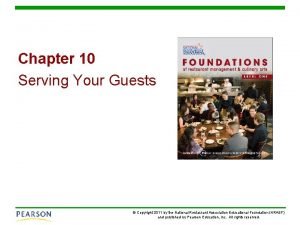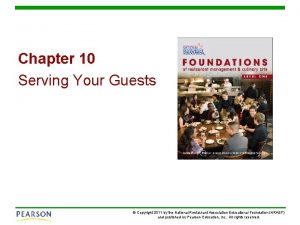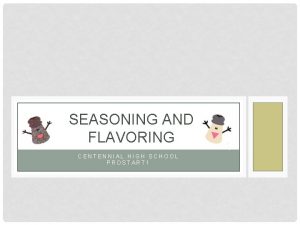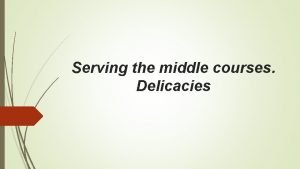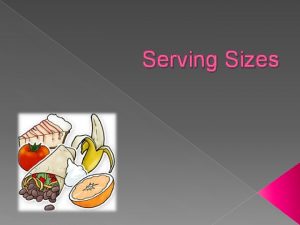Chapter 10 Serving Your Guests PROSTART LEVEL 1























- Slides: 23

Chapter 10 Serving Your Guests PROSTART LEVEL 1

Definition of Hospitality 2 Hospitality is the feeling that guests take with them from their experience with the operation. Service Care Attention When the offerings of competitors are similar, the competitive advantage often comes from the nature and quality of customer service. Working in a service industry means serving people directly. This is the single most important aspect of the job. 10. 1 Chapter 10 | Serving Your Guests

First Impressions 3 A strong first impression is one of the least expensive and most effective forms of advertising. The initial customer interaction is one of the best ways in which to make a strong first impression. The appearance of all restaurant and foodservice employees also affects a guest’s first impression. 10. 1 Chapter 10 | Serving Your Guests First impressions are often the strongest impression we have of a person, place, or event.

What does a first impression accomplish? 4 Makes the customer feel welcome in your establishment 2. Helps the customer feel confident about their decision to come to your establishment 3. Sets the stage for a good dining experience 4. Makes customers more likely to forgive minor errors 1. The exterior of the building is important to a first impression because it is often the first thing the guests’ see. 10/30/2020

Employee Attributes for a First Impression 5 1. Dress Appropriately • Wear clean, wrinkle-free clothing • Clothing in good condition 2. Practice Good Hygiene • Includes hands, nails, face, and hair 3. Jewelry • Depends on the policy of management or health codes in the area 10/30/2020

Identifying Customers’ Needs 6 It is up to all employees to ensure prompt, friendly, and professional service. They should start by identifying the customer’s needs. Older customers may need Special occasions usually mean additional help. Families with young children also may have special needs. Customers may have special dietary needs, so knowledge of the menu is critical. First-time guests might be unfamiliar with the menu or any special touches of an operation. that the customer has specific needs. Foreign-language differences present challenges to efficient and responsive service. Employees need to accommodate people with disabilities in every way possible. People dining alone may have work to do or may simply be trying to get away from it all. 10. 1 Chapter 10 | Serving Your Guests

Greeters Responsibility 7 The greeter provides the first impression in appearance, friendliness, and attentiveness. Asking if customers have any reservations 2. Noting special dietary needs, seating arrangements, celebrations, etc. 3. Arranging for the customer to be escorted to their seats. 1.

Reservations and Requests 8 It is very important to have an accurate system to record reservations and special requests and implement them at the right time. Reservations and requests should be saved in one place and include standard information, including when and who recorded the information. Confirming all reservations and special requests is good customer service. With proper procedures, establishments can avoid making mistakes when taking reservations and completing special requests to avoid disappointing guests. 10. 2 Chapter 10 | Serving Your Guests

Greeting and Taking Orders 9 The greeter evaluates and determines the customer’s specific needs for the current visit. As each guest at the table selects their meal, the server notes guest orders on pre-printed guest checks or small note pads. Some guests may ask the server whether certain ingredients can be removed from dishes due to food allergies or other special needs. 10. 2 Servers need to note correctly any special requirements and ensure that the chef understands the request. Chapter 10 | Serving Your Guests

Suggestive Selling 10 Suggestive selling involves recommending additional or different items to a guest. 1. 2. 3. 4. 5. 6. 7. 8. 9. 10. 2 Enhance communication skills Develop the server’s product knowledge Learning items that work well together Anticipating the customer’s needs Suggesting add-on items like drinks and desserts Suggest items that you enjoy Selling the restaurants “best” items Use props Observe guests behavior Chapter 10 | Serving Your Guests

Alcohol Service 11 Alcohol service is often an integral part of a dining experience. Every state’s liquor board or liquor authority develops and enforces its own regulations for alcohol service. The amount of alcohol absorbed into a person’s bloodstream is called blood alcohol content (BAC). A BAC of 0. 10 means that there is about one drop of alcohol present for every thousand drops of blood. It is against the law to drive with a BAC of 0. 08 or higher in all 50 states. You must be 21 years old to purchase alcohol in all 50 states. In general, a server must be 21 years old to serve alcohol. If you sell or serve alcohol, you are responsible for ensuring that customers are of legal age by checking their IDs. When an alcohol-related incident occurs on an operation’s premises, the manager often needs to file a report. 10. 2 Chapter 10 | Serving Your Guests

Processing Payment 12 Processing payment is as vital a function as greeting the customers or serving the food. Most establishments accept cash or credit. The procedure for processing payment as part of table service is very similar to processing at a register: 1. Present the check at the table. 2. Collect payment from the customers. 3. Process payment. 4. Return the change or credit card receipt and credit card. For credit card payments, bring the credit card and receipt to the table together. Always remember to thank customers for their patronage. 10. 2 Chapter 10 | Serving Your Guests

Getting Feedback on Customer Satisfaction 13 To determine how well the restaurant or foodservice operation meets guests’ expectations, it is useful to measure their satisfaction. Routinely ask whether the food, drink, service, and accommodations are satisfactory during a guest’s visit. Comment cards are quick surveys that customers complete noting their satisfaction with the food and service. Surveys are similar to comment cards but sometimes include more open-ended questions. Focus groups consist of customers that meet as a group to talk with managers about possible improvements in service or other areas. Mystery shoppers are hired by an operation to visit and report on their experiences and impressions of an operation. 10. 2 Chapter 10 | Serving Your Guests

Resolving Customer Complaints 14 An unhappy customer is bad for business, so every operation needs an organized system for handling and resolving all guest complaints. Management must train every staff member on how to handle customer complaints. It is important to recognize when a guest is upset so that the problem can quickly be resolved. Actively look to see if the guest is showing signs of being unhappy with the service or meal, and then encourage the guest to explain the problem. Never ignore or avoid a dissatisfied guest. Proactively addressing such concerns with customers can turn a dissatisfied customer into a repeat guest. 10. 2 Chapter 10 | Serving Your Guests

Contemporary and Traditional Service 15 Quick service is an easy and fast way to dine and typically involves no servers. Guests help themselves to food set up in food bars or order at a counter. Drive-through Buffets Carry Outs Vending Machines Cafeterias Traditional service style reflects four main influences: American, French, English, and Russian. Each service style varies depending on the menu, theme, and décor: 10. 3 Chapter 10 | Serving Your Guests

Traditional Service 16 • American service: • • Food is arranged on plates in the kitchen by cooks and brought directly to the guests’ table by the server. The meal is complete on one plate. French service: This style is typically considered the most elegant, It is very expensive. Servers present the food to guests from a tableside cart, called a guéridon. 10/30/2020

Contemporary and Traditional Service 17 English service: Family-style dining English service is the simplest and least expensive. In English service, bowls and platters of food are placed on the table, and a seated host or hostess places the food onto plates. The host of the table then serves the meal 10. 3 Chapter 10 | Serving Your Guests Russian service: This style is the most formal service style. All food preparation is done in the kitchen. The bowls and platters of food are then brought on a cart to guests at the table. Servers hold the bowls and platters as they serve the food to each guest.

Additional Service Items 18 Charger: Service plates that don’t directly touch the food Tureen: Large covered bowl to serve soup for up to eight people Finger Bowl: A small bowl filled with water and often citrus fruits to clean fingers after eating 10/30/2020

Traditional Service Set-ups 19 Understanding the many types of silverware that an operation uses is very important. The basic knives used most often when dining include the following: Dinner knife: Used for all entrées and main courses. Butter knife: Smaller than a dinner knife and used to butter bread or cut breakfast foods, fruit, and other softer foods. Fish knife: Used only to filet and cut fish. Steak knife: Used to cut beef. 10. 3 Chapter 10 | Serving Your Guests

Traditional Service Set-ups 20 Forks Spoons Single-Purpose China 10. 3 Chapter 10 | Serving Your Guests Drinking Glasses

Traditional Service Staff Responsibilities 21 Large, traditional, full-service restaurants have a formal service organization. The maître d’hotel is responsible for the overall management of service. The headwaiter is responsible for service in a particular area. The captain is responsible for a server area, and is assisted by the front waiter or an apprentice. The front waiter has only 1 to 2 years of experience. An apprentice is a server in training. 10. 3 Chapter 10 | Serving Your Guests

Traditional Service Staff Responsibilities 22 In less formal service structures, a floor manager might run the dining room. The floor manager is in charge of the operation during a particular shift and supervises a team of servers. Each individual server is responsible for a specific section of the dining room. Food runners are sometimes employed to assist with bringing food from the kitchen to the tables. Busers assist with the cleaning up and resetting of tables. 10. 3 Chapter 10 | Serving Your Guests

Service Tools and Stations 23 In full-service restaurants, servers usually carry many different service tools with them. § Service tools may include a hand towel, a lighter, a corkscrew, change, a pen, an order pad, and sometimes a crumber, which is used to neatly gather and clear crumbs and debris from a table cloth. The service station is the area in which an operation keeps additional items such as napkins, silverware, cups and saucers, condiments, menus, and water glasses. Servers use different serving utensils when they serve food to guests. 10. 3 Chapter 10 | Serving Your Guests
 Chapter 10 serving your guests
Chapter 10 serving your guests Chapter 10 serving your guests
Chapter 10 serving your guests Chapter 10 serving your guests
Chapter 10 serving your guests Prostart chapter 2
Prostart chapter 2 Sequence of food menu
Sequence of food menu Prostart battery lookup
Prostart battery lookup Salad that stimulate the appetite
Salad that stimulate the appetite Multi-level serving trees dremel
Multi-level serving trees dremel Good morning ladies and gentlemen speech
Good morning ladies and gentlemen speech Missing in venice harris burdick
Missing in venice harris burdick Great gatsby ch 3 questions
Great gatsby ch 3 questions How might a valet satisfy a valet-serviced guest?
How might a valet satisfy a valet-serviced guest? Types and styles of room service trays and trolleys
Types and styles of room service trays and trolleys Good evening ladies and gentlemen speech
Good evening ladies and gentlemen speech Assisting guests
Assisting guests The mysteries of harris burdick captain tory
The mysteries of harris burdick captain tory Why do prince prospero and his followers retreat
Why do prince prospero and his followers retreat What types of housekeeping requests guests make
What types of housekeeping requests guests make Dear guests welcome
Dear guests welcome Dear honorable guests
Dear honorable guests Welcome dear guests
Welcome dear guests Meeting the needs of guests with kindness and goodwill.
Meeting the needs of guests with kindness and goodwill. Explain how the party is constantly disrupted.
Explain how the party is constantly disrupted. Distinguished guests ladies and gentlemen
Distinguished guests ladies and gentlemen






